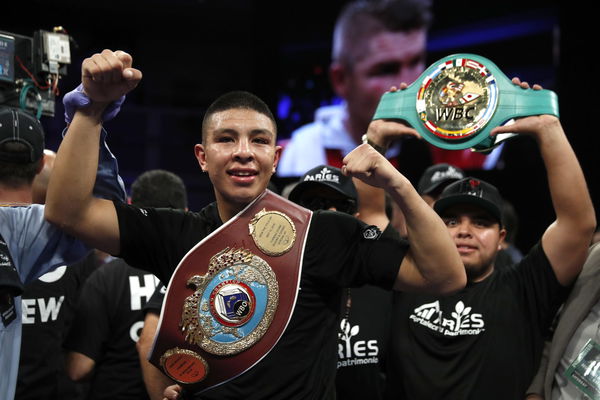49 Years After ‘The Rumble in the Jungle’, Michael Jai White Explains Why Muhammad Ali Could “Float” Even Against a 4-Pound Heavier George Foreman

Follow Us

via Getty
New York, N.Y.: Joe Frazier, left, hits Muhammad Ali during the 15th round of their heavyweight boxing title fight at New York’s Madison Square Garden on March 8, 1971. (Photo by Dick Morseman/Newsday RM via Getty Images)
On October 30, 1974, Muhammad Ali, at 32 years old, reclaimed the heavyweight championship for the second time by defeating the 25-year-old champion George Foreman in the eighth round of the ‘Rumble in the Jungle’ held in Kinshasa, Zaire. Ali had previously lost his title seven years earlier due to government accusations of dodging the draft. This led to the revocation of his boxing license by the commission. His triumph in Zaire marked him as only the second former champion in history to regain the heavyweight title.
Michael Jai White, the American actor and martial artist, in a recent interview with DJ Vlad, explained what gave Ali the edge over Foreman. How important were their respective weights that titled the decision in the other person’s favor?
Michael Jai White on why Muhammed Ali had an upper hand
ADVERTISEMENT
Article continues below this ad
In White’s opinion, there isn’t a significant difference between Muhammad Ali and George Foreman in terms of weight. On fight day, Ali weighed 214 pounds, while Foreman was 218 pounds, just a four-pound difference. However, what sets Ali apart is the speed and size of his legs. “They’re four pounds different in weight. One was 214, the other one was 218. Now on fight day they could have been the same. Ali could have been bigger. But Ali’s legs were definitely bigger than Foreman’s,” conveyed White.
Trending

Jaime Munguia’s Wholesome Moment With His Wife and Baby Goes Unnoticed Due to Golden Boys’ Embarrassing Mistake, Fan Points Out
May 05, 2024 06:40 AM EDT

“She’s a Sweetheart”: Jaime Munguia’s Wife Alejandra Steals the Show Ahead of Canelo Alvarez Showdown
May 04, 2024 01:11 PM EDT

“He’s Not Stuck in Dubai”: Floyd Mayweather’s $30,000 Act of Kindness Towards Homeless Men in LA Raises Questions About Gervonta Davis’ Bombshell Claim
May 03, 2024 06:58 AM EDT

Terence Crawford Responds to Kendrick Lamar’s Drake Diss Track With Bold Declaration
May 02, 2024 03:35 PM EDT

Canelo Alvarez’s Hard-Hitting Confession About Floyd Mayweather Loss Goes Viral Hours Before Jaime Munguia Fight
May 05, 2024 04:59 AM EDT
Get instantly notified of the hottest Boxing stories via Google! Click on Follow Us and Tap the Blue Star.

Follow Us
This detail is crucial because Ali, being a heavyweight, could move faster, giving him an advantage in the ring. People tend to overlook that Ali was often the larger fighter in the ring. His ability to move swiftly was due to his powerful and well-balanced legs.
In boxing, having such a well-built physique, especially in the legs, allowed Ali to move gracefully and float around the ring which is the thought that Michael Jai White conveyed. “He’s a big dude moving fast. Yeah, so that’s the thing, and his legs I mean Ali is balanced from head to toe and so for boxing. I’d say that’s a better build, for.. to move around that’s why he floated on his legs because they were powerful,” explained White.
What characterized Ali’s speed and footwork?
ADVERTISEMENT
Article continues below this ad
Boxing enthusiasts widely regard Ali as the fastest heavyweight in boxing history, showcasing mental and physical strength that proved overwhelming for his opponents. His speed, a paramount asset, was demonstrated in a Sports Illustrated test in 1969. Ali’s jab, measured with an omega scope, smashed a wooden board 16.5 inches away in just 4/100 of a second. Note that this is equivalent to the blink of an eye.
Despite his size, Ali’s speed surpassed that of most lightweights, combining precision with rapid combinations. His footwork, marked by agility and efficiency, was a trademark, making it challenging for opponents to keep up. Ali’s iconic movement, encapsulated by his famous mantra “Float like a butterfly and sting like a bee,” involved bouncing, shuffling, feinting, and pivoting in ways unconventional for heavyweights.
ADVERTISEMENT
Article continues below this ad
Ali’s genius skills inside the ring continue to spark discussions to this day. Do you agree with White’s analysis? Let us know in the comments below.
Watch This Story: Remembering this day in history, 30th October 1974 Muhammad Ali vs George Foreman’s Rumble in the Jungle
Edited by:

Gokul Pillai


